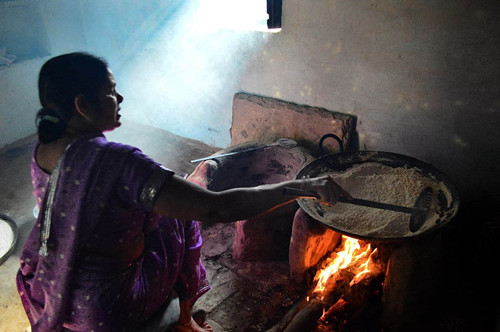Indoor air pollution is the contamination of the indoor air caused by pollutants and sources like Carbon Monoxide, Particulate Matter, Volatile Organic Compounds, Radon, Mould and Ozone. While outdoor air pollution has captured the attention of millions, the worst air quality that you experience everyday may be coming from your homes.
—
What is Indoor Air Pollution?
There exists a relatively unknown pollution that lurks around us. While pollution in general is certainly an integral aspect from an environmental and health perspective, such as water or noise, many of us are unaware that indoor air pollution has triggered several health risks in children and adults over the years. In fact, the US Environmental Protection Agency (EPA) ranks it as one of the top five environmental dangers.
We spend about 90% of our time indoors and it is a proven fact that indoor emissions also contaminate the air. These indoor emissions can be natural or anthropogenic; they originate from the air we breathe to the indoor circulation and to a certain extent, from furniture articles. These emissions result in indoor air pollution.
We believe in One Planet Thriving
Join us in the fight for a Healthy Thriving Planet
Indoor air pollution is the pollution (or contamination) of the indoor air caused by pollutants and sources like Carbon Monoxide, Particulate Matter (PM 2.5), Volatile Organic Compounds (VOCs), Radon, Mould and Ozone.
Every year, almost four million premature deaths are recorded around the world due to indoor air pollution and many more suffer from diseases linked to it, such as asthma, heart diseases and cancer. Household air pollution caused by burning of unclean fuels and solid fuel stoves releases dangerous pollutants like Nitrogen Oxides, Carbon Monoxides and Particulate Matter. What makes this even more concerning is that the air pollution caused indoors can contribute to almost 500,00 premature deaths attributed to outdoor air pollution annually.
Indoor air pollution is deeply linked to inequality and poverty as well. A healthy environment is recognised as a constitutional right of the people. In spite of this, there are roughly three billion people who use unclean sources of fuels and live in some of the poorest nations in the world such as Africa, Latin American and Asian countries. Furthermore, the existing technologies and fuels used indoors already pose severe risks. Injuries such as burns and ingestion of kerosene are all linked to household energy used for lighting, cooking and other related purposes.
There is also a disproportionality that exists when referring to this hidden pollution. Women and girls are known to be affected the most due to them spending larger time indoors. According to an analysis conducted by the World Health Organisation in 2016, girls in households that depend on unclean fuels lose around 20 hours each week gathering wood or water; this means that they are at a disadvantage, both in comparison to households that have access to clean fuels, as well as to their male counterparts.
So how does indoor air pollution relate to climate change?
Black carbon (also known as soot) and methane – a greenhouse gas that is more potent is carbon dioxide – emitted by inefficient combustion in households are powerful pollutants contributing to climate change. Household cooking and heating appliances account for the highest source of black carbon which basically involve the use of coal briquettes, wooden stoves and traditional cooking appliances. Furthermore, black carbon has a stronger warming impact than carbon dioxide; around 460 -1,500 times stronger than carbon dioxide per unit of mass.
Climate change in turn, can also affect the air we breathe indoors. Rising carbon dioxide levels and increasing temperatures can trigger outdoor allergen concentrations, which can infiltrate indoor spaces. Extreme weather events in recent decades have also downgraded indoor air quality by increasing dampness, which results in an increase in dust, mould and bacteria.
The conundrum of indoor air pollution brings us to “indoor air quality”. Indoor air quality (IAQ) refers to the air quality in and around buildings and structures, and relates to the health, comfort and well-being of building occupants. In sum, indoor air quality is determined by the pollution indoors. Therefore, to address and improve IAQ, is to tackle indoor air pollution sources.
You might also like: 15 Most Polluted Cities in the World
Ways to Reduce Indoor Air Pollution
To start with, household pollution is something that can be curbed to a good extent. Since we all cook in our homes, using cleaner fuels like biogas, ethanol and other renewable energy sources can certainly take us a step forward. An added benefit to this, would be the reduction in forest degradation and habitat loss – replacing biomass and other wood sources – which can also address the pressing issue of global climate change.
Through the Climate and Clean Air Coalition, the United Nations Environment Programme (UNEP) has also taken steps to prioritise the adoption of cleaner energy sources and technologies that can improve air quality, reduce air pollutants, and bring to the forefront the importance of environmental, social and economic benefits of the same. This voluntary partnership of governments, organisations, scientific institutions, businesses and civil society organisations was borne out of initiatives created to solve air quality and protect the globe by reducing short-lived climate pollutants (SLCPs).
The World Health Organization (WHO) also raises awareness of household air pollution at country and regional levels through workshops and direct consultations. They have created a Clean Household Energy Solutions Toolkit (CHEST), a repository of information and resources to identify stakeholders working on household energy solutions and public health issues to design, apply and monitor processes concerning household energy use.
On the individual level, there are ways in which we can ensure cleaner air in our homes. It is certain that awareness is key. Many of us should learn and understand the source of pollution from our homes, whether it comes from ink, printers, carpets, furniture, cooking appliances, etc.
Keep check of the air fresheners that you use at home. While many of us are inclined to keep our homes odour-free and welcoming, some of these can be a source of pollution. To be more specific, reduce the use of air fresheners which contain limonene; this can be a source of VOCs. Ventilation is of utmost importance. Opening our windows for relevant periods of time, using certified and efficient air filters and exhaust fans are easy first steps to begin with. Consider doing an air quality assessment, especially in offices and large residential areas, to understand the different parameters that govern indoor air quality. Also, regular checks of pipes for leaks and window frames after a downpour can help prevent the growth of damp and mould. This also means keeping humidity levels between 30%-50% in areas which are likely to gather moisture.
Indoor air quality and pollution are two concepts which have and tend to be ignored. But with the right mind-set and healthy lifestyle, we can always adapt to change, even in our homes. This can lead to cleaner air and breathable environments for ourselves and children, and in turn, lead to a safer living.
From earth.org.
Post time: Aug-02-2022

